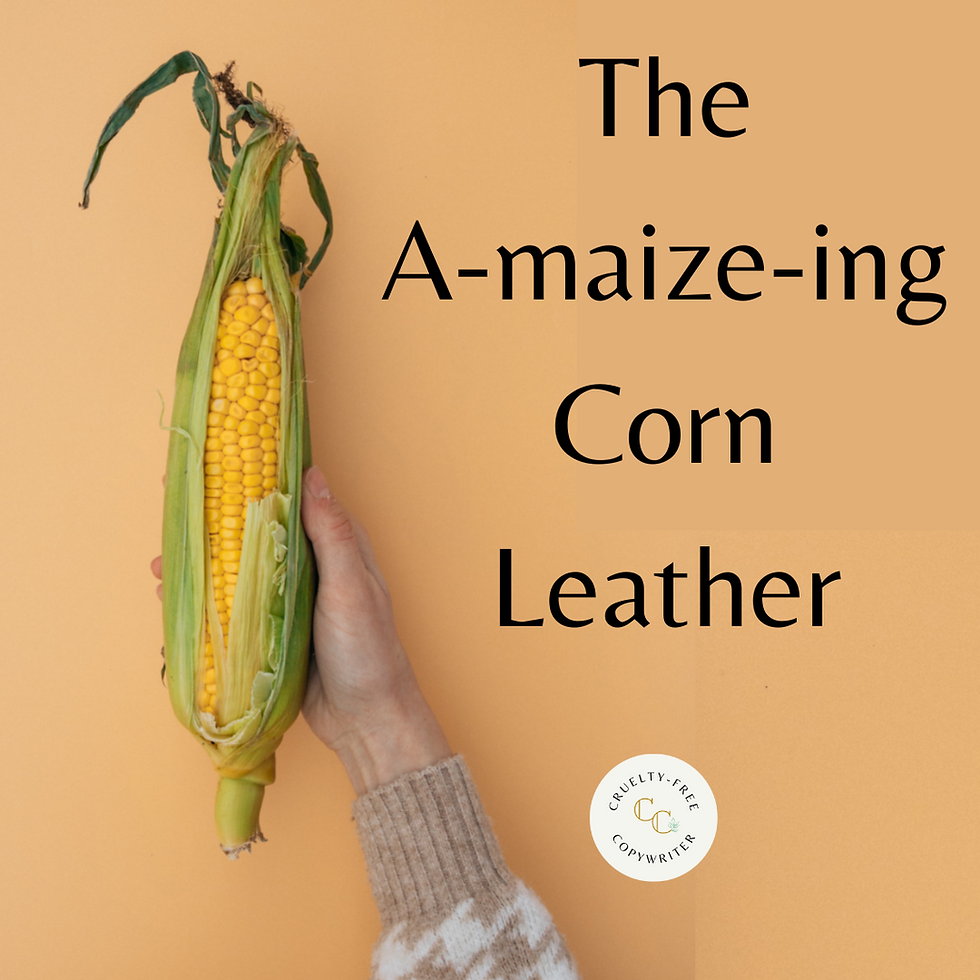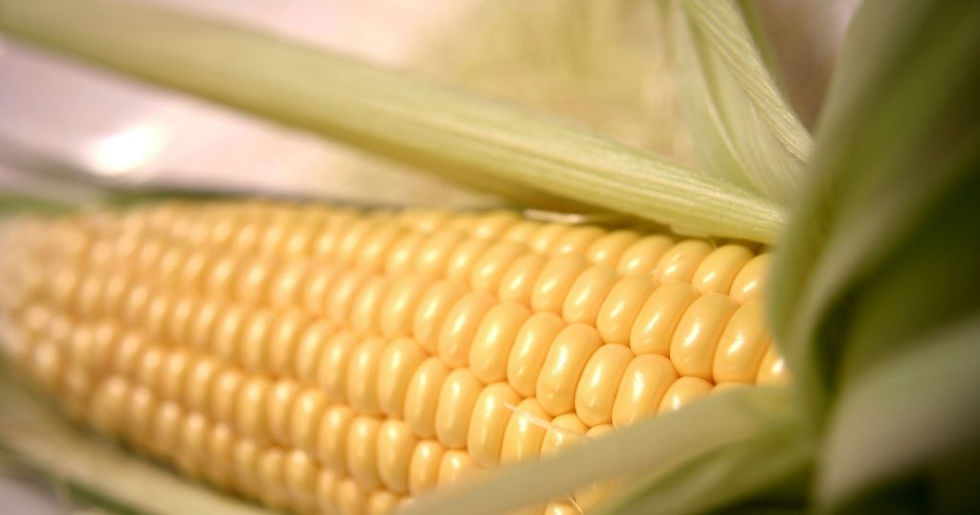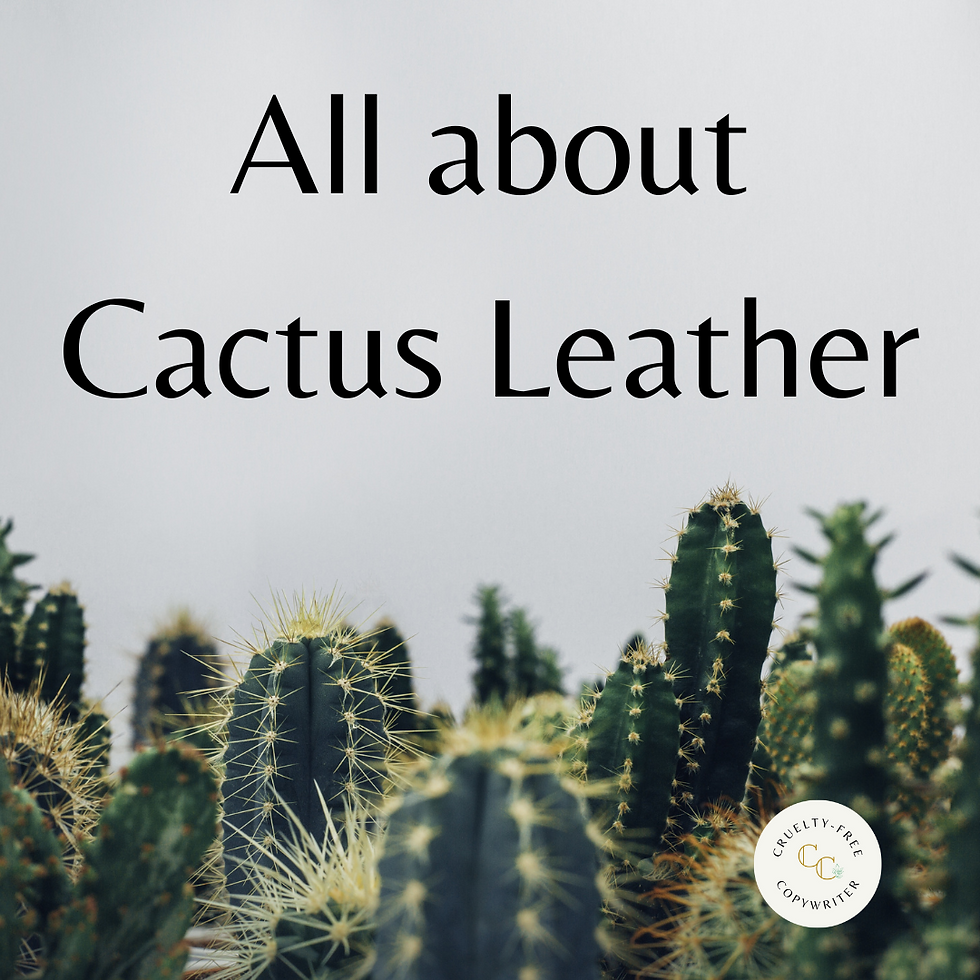The A-maize-ing Corn Leather
- Topaz Hooper
- Aug 18, 2022
- 5 min read
How did corn on the cob become a clutch? Read on and discover how corn leather is taking the fashion world by storm.

Corn. The thing most Americans eat on a hot Saturday afternoon in the dead of summer. This yellow grain indigenous to the Americas is undergoing a rebrand. It’s no longer just food, it’s also fashion.
Introducing…Corn Leather.
This new plant-based leather alternative is now being made into shoes, handbags, accessories, and more. But how is this plant transformed into “leather” and is it more sustainable than animal leather?
We'll explore these questions and more in today’s article all about corn leather.
What is corn leather?

Corn leather is a cruelty-free, plant-based leather alternative made up of non-GMO corn and polyurethane (PU). Corn leather is made with recycled plastic bottles and bio polyols, obtained partly from GMO-free corn.
Unfortunately, this leather alternative isn’t made of 100% corn as we’ve seen in apple leather or cactus leather. This mix is primarily made of corn but still contains some petroleum products (more on the sustainability of corn leather later).
Who makes corn leather?
Corn leather is most widely manufactured by BioVeg, a sub-brand of the Italian synthetic leather manufacturer, Coronet. The brand primarily produces PU and has most recently expanded to creating PU and plant-based leather combinations.
The brand claims its corn leather has the highest percentage of biomaterial on the market, up to 81% biomass, which includes non-GMO corn.
How is corn leather made?

According to the manufacturer:
“The corn is collected and then treated and processed into bio-based polyols, microparticles essential for the production of bio-based polyurethane, an ecological and performing material.”
In plain English, corn grows naturally out of the ground and is then harvested. Obviously, some corn goes to your average grocery store, while other crops and their waste goes to manufacturers. The corn undergoes a fermentation process to extract dextrose (a type of sugar) from the corn.
The fiber used to make corn leather is made from that magical, sweet dextrose. From there, the dextrose is used to create a polymer (a synthetic substance/material) and formed into pellets, which then are used to make the leather-like fabric.
Phew! That was a lot of big words. I think you get the point. Corn from the ground turns into sugar turns into pellets turns into fabric. Done! Can we get corn on the cob now?
Is corn leather eco-friendly?

And the question of sustainability begins. At Cruelty-Free Copywriter, part of my goal is to serve game-changing cruelty-free brands. Just because something is vegan and plant-based doesn’t mean it’s sustainable. So, let's be honest and look at the material objectively.
Perhaps a petroleum-mixed plant-based material can have a lower environmental impact than traditional factory-farmed leather. Let’s see!
Chances are the corn grown for corn leather was likely produced in the USA since it’s the biggest corn producer in the world and accounts for nearly one-third of global corn production. Makes sense since corn is indigenous to the Americas and the USA sure loves its popcorn.
BioVeg claims the corn used in their leather alternatives is non-GMO which does have a positive impact on the environment.
However, as mentioned before, corn leather isn’t 100% corn. The fiber is semi-natural but contains polyurethane (a petroleum-based product). It’s supposedly composed of up to 80% corn waste but ratios may vary from 47% to 82% corn pulp. Given its big oily footprint, we can’t say corn leather is super sustainable.
However, there are some upsides (and downsides) worth noting.
Corn leather is durable.
It’s resistant, durable, and (apparently) tougher than animal hide. This offers some environmental benefits because having a product that lasts a long time can help increase its usability and lifespan in the average fashionista's closet.
Corn leather is versatile
It has a smooth texture that is just as pleasant as traditional leather. It contains much of the same touch, feels, and elasticity as the typical leather product. Therefore, can replace traditional animal leather and produce a lower environmental impact.
Corn leather is partially biodegradable
It’s estimated corn leather may be up to 63 percent biodegradable. Although that's not 100% biodegradable, it's better than traditional PU which is very difficult to biodegrade.
Corn leather reduces waste
Even though growing corn may have its issues, repurposing corn waste can be helpful on the sustainability scale. Since corn leather uses leftover corn waste from the food industry, we’re keeping that waste out of the landfills and companies are using it to create something new.
Corn isn’t a sustainable crop
It’s common knowledge that corn crops deplete nitrogen and other nutrients in the soil. The US monocropping industry has caused substantial environmental damage to soil health all across the nation. By growing corn, whether it’s for food or fashion, consumers and manufacturers alike contribute to the degradation of soil quality and therefore ecosystem health.
Not to mention, most corn crops in the USA are dowsed with pesticides and fertilizers that negatively impact the air, water, animals, and insects on the planet.
Corn leather is moderately sustainable
With all of this information, I would say corn leather is moderately sustainable. It’s not a “good guy”, it’s not a “bad guy”. It’s just a guy. Still, I would say it’s better than using animal leather due to the reduction in animal harm, animal waste, deforestation from animal agriculture, and pollution from tanning animal leather.
Where can I buy corn leather goods?
I’m glad you asked. I found a few notable brands serving up corn leather lewksss that I think you’ll love.
Men don’t often get to have nice, innovative things in the fashion world. But, Solari Milano is changing that. The Italian-based brand produces sleek and elegant men’s formal shoes. Using corn leather as their main material while also utilizing organic cotton for their shoelaces and bamboo for their interior lining.
2. Miomojo
Another Italian-based fashion brand, Miomoji produces high-quality handbags from several plant-based materials including corn leather. They combine Italian design with sustainable materials of the future. Plus, they donate 10% of their income to animal welfare charities.
3. Mashu London
These European brands are killing it, right? Actually, they’re saving lives. Mashu London is a UK-based brand that makes luxurious handbags using plant-based leather alternatives including corn leather. They manufacture their bags in the beautiful country of Greece where each bag is made with care and precision. They’re revered for their commitment to protecting the environment while also protecting your style.
4. Alexandra K
Alexandra K’s Polish-made vegan leather bags feature corn leather and other alternatives. Their high-fashion products have been recognized nationally and internationally for their sophisticated design and innovative materials. When fashion meets function meets sustainability, how can you lose?
Let’s talk cruelty-free
Oh boy, do I love corn. I love corn on the cob, popcorn, and writing about your corn leather goods. If you liked what you read and want a cruelty-free expert to craft copy and content that inspires your audience, contact me, and let’s chat. I’ve worked with sustainable fashion brands, clean beauty, health, wellness, and innovative tech brands to make robotic copy sound luxurious and relatable. Don’t hesitate. Your copy and content can’t wait. Let’s have a chat.








Comments